Dad pride
June 13, 2013
As we prepare to celebrate our nation’s dads this weekend, how’s this for a heroic (not to mention exhausting) feat of fatherhood? For three consecutive months in mid-2005, Los Angeles County social workers delivered three tiny foster children to a couple who’d once tucked away any hope of being parents.
The oldest of the children was 18 months. The middle one was 4 months. And the youngest had been in the world for just 3 days.
“We made it through that glorious summer, a scorcher without air conditioning,” says John Ireland, as he recalls the diapers and feedings and joys of it all. “It was such a tremendous, intensive parenting experience”—one made even more complicated by the demographics of the household. For there were two men of the house, “Dad” and “Daddy.” John is married to Duncan Ireland, his partner of 20 years.
Like many gay men, John, 42, says he’d come to believe the subtle and overt messages in society that parenthood was out of reach for people like him. His own parents, he says, “let go” of their hopes of having grandchildren through him after he “came out.”
But all that changed, John says, after he and Duncan talked to social workers from L.A. County’s Department of Children and Family Services and the Southern California Foster Family & Adoption Agency during an informational fair at Plummer Park in West Hollywood.
“We were not only welcomed, we were actively recruited,” John says, noting that he and Duncan, 40, promptly underwent nine training sessions for certification as foster parents. That training included an emphasis on family transparency. “What they need is honesty. You don’t avoid any topics with a foster child,” says John, who was wed to Duncan in 2008, before California voters banned same-sex marriage through Proposition 8, which is under review by the U.S. Supreme Court.
In all, the couple provided foster care to four children, eventually adopting a sister and brother, now 8 and 5, respectively. “We would have adopted them all, if we could have,” says John, a consultant and fundraiser for non-profit groups who served as the stay-at-home dad while Duncan continued his law practice. Today, John helps lead an organization called Raise A Child, which works with the county and others to spread the word about opportunities for gays and lesbians to become foster and adoptive parents.
County child welfare officials know that some people may not approve of the government actively seeking gay and lesbian parents. But those officials say the county needs every willing and qualified adult possible to provide a safe and caring environment for the more than 16,000 foster youth who must be removed from dangerous homes.
“We need to recruit everyone who can help us”—including lesbian, gay, bisexual and transgender couples and individuals—says DCFS supervising children’s social worker Bryan Miller. “The LGBT community has been an underutilized resource for many years. We’re just catching up.” Miller says a UCLA study last year concluded that foster children do equally well when placed with gay, lesbian or heterosexual parents.
As for the critics, Miller offers this challenge: “If you’re going to complain, I want to see you at our next foster/adoption orientation.”
In recent years, the county’s foster care system has come under intense scrutiny and criticism for sometimes failing to protect the welfare of children living in group or individual homes. Just this week, the Board of Supervisors voted to end a decades-long relationship with Teens Happy Homes amid allegations of financial improprieties and child abuse detailed in the Los Angeles Times. But what rarely rises to the surface are the many profound and touching stories of success. As John explains: “These victories are small and only celebrated by those of us observing them happen.”
The experiences of John and Duncan, both as foster and adoptive parents, deserve a wider celebration.
As foster parents, John says, you’re trained to brace for the reality that the children you’ve grown to love may be reunified with relatives. That’s what happened with two of those first three youngsters to enter the couple’s life in rapid succession—Marisol and her infant brother, Isaías. Five months after coming to the Ireland home, the children were adopted by an aunt living near Staples Center in downtown Los Angeles. “We thought we’d never see them again,” John recalls.
When he and Duncan arrived at the aunt’s apartment, siblings in tow, she asked whether they had a keepsake photograph of the children and their foster parents. In fact, John had stashed a framed picture in their suitcase. He dug it out and handed it to her. To the men’s astonishment, she removed an image of the Virgin Mary from a wall and replaced it with the new photo.
“You are part of their lives and we want you to be part of our family,” she told them, a vow to which she’s stayed true during the past eight years by inviting the couple to birthday parties and other special occasions. “That was the best thing for those children,” John says in hindsight. “It worked exactly as the foster system was meant to be.”
As for baby No. 3, Emma, the couple adopted her in late 2005, six months after she first came to their home. And she remained an only child for nearly seven years, until John got a mid-morning call while driving along Laurel Canyon Boulevard. “Pull over and turn off the car,” an excited social worker advised. Emma’s 4-year-old brother, she reported, had entered the foster care system. Little Giovanni, who joined the family as a foster child in July, 2012, was adopted last month.
“He was so excited about being adopted,” John says, “that for two weeks when he woke up in the morning he’d ask: “Am I still a foster kid?” I’d tell him, ‘Nope, you’re no longer a foster kid.”
John is under no illusions that his family choices will be widely embraced, especially by those outside “the bubble” of Los Angeles. Not only are there two dads, but they’re white with African American children. “We don’t walk into a restaurant undercover,” he joked.
Asked what unique challenges gay couples confront, John says: “The biggest challenge is helping our kids navigate a society that is very focused on us. The spotlight is trained on our families. It’s still very controversial in our culture for gays and lesbians to parent.”
“The hardest part,” he continues,”is when we go into public. The kids are old enough to see the looks or be posed the questions in school. ‘Why do you have two dads?’ We have to prepare them to answer those questions.”
Two weeks ago, he says, he and his husband took the youngsters to a gay pride festival in the Antelope Valley. Along the road to the fairgrounds were protest signs warning, “Homo sin. Turn back.”
“How do you prepare a 5-year-old or an 8-year-old for that? We tell them that people have the right to express themselves. Some people do not agree with our family. Some people do not like families with only one parent.…The truth is that every kid has something they can be picked on about. Kids need to be taught resilience.”
This Sunday, none of those questions or pressures will be in the air when John, Duncan and their two high-energy, toothy-grinned kids who love handball and running attend “The World’s Largest Gay Father’s Day Celebration,” which includes brunch and a children’s concert.
The event is sponsored by, among others, John’s Raise A Child group, the City of West Hollywood and the Pop Luck Club, an organization of gay dads, prospective dads and their families. John is the current president, with duties that include storing the club’s banners in his garage and making sure there’s plenty of Capri Sun juice boxes for monthly potlucks.
Says John: “I think I’m the luckiest guy in the world…besides my husband.”
Posted 6/13/13
L.A.’s biggest science project ever
June 13, 2013
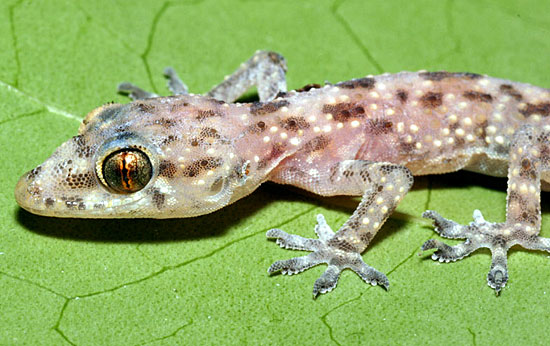
Natural History Museum “citizen science” yielded the first L.A. sighting of this gecko species. Photo/Gary Nafis
When the Natural History Museum of Los Angeles County launched its recent renovation, one of the goals was to make room for more science. Turns out it also made room for more scientists—of the backyard amateur variety, no lab coat required.
With the addition of the new Nature Lab and Nature Gardens as part of its centennial celebration, the museum’s growing involvement in so-called “citizen science” projects has gained new prominence, enlisting Southern Californians by the thousands in projects to catalogue the region’s biodiversity.
From insect counts to inventories of freeway roadkill, the museum has more than a dozen initiatives that are either ongoing or in the works now in which the public is playing a key role in the study of wildlife in Los Angeles County.
“It’s like crowdsourcing, and it can be an amazing resource,” says Lila Higgins, manager of citizen science and live animals at the museum.
Also known as participatory science, citizen science has become increasingly common as technology has made it easier for scientists, professional and amateur, to share observations and collaborate.
“In some ways, it isn’t new,” says Greg Pauly, curator of herpetology at the Natural History Museum, noting that volunteers at the NHM’s Page Museum have been helping process fossils for many years. “But with the Internet and smart phones and other digital devices, anyone can, say, photograph an organism and send it over the net to be included in scientific research. And people of all ages can help that way.”
Worldwide projects, such as the extraterrestrial life site SETI@Home, and the ornithology database eBird, have been reaching out to the public for more than a decade, and the Natural History Museum has been among the local pioneers of the concept. As far back as 1994, for instance, museum ornithologists enlisted the public in a study of feral parrots in Southern California.
The California Parrot Project, which is still ongoing, asked birdwatchers to let the study’s organizers know about local parrot sightings, and eventually yielded one of the first reliable counts of the numbers—upwards of a dozen species—of parrots breeding in the wild here, says Kimball L. Garrett, ornithology collections manager at the museum.
“It was extremely primitive—we’d mail out newsletters,” says Garrett. “But all this research from the mid-1990s gave us a baseline to figure out whether these populations are expanding or contracting now.”
Of the museum’s current batch of citizen science projects, the oldest is the 11-year-old Spider Survey, which asks the public to collect spiders in their homes and gardens, take down some data and bring or send what they find to the museum, Higgins says.
“At the time, it was the cutting-edge thing,” she remembers. “We launched it in 2002 at the museum’s Bug Fair, and the first week, a thousand spiders came in.”
Since then, some 6,000 spiders have been sent into the museum from throughout Los Angeles County; among the project’s findings was the first sighting of a brown widow spider in L.A.
“We’re a port city with people and goods coming and going on a daily basis, and with them, creatures sometimes hitch a ride,” Higgins explains.
Other citizen science projects have yielded even more exciting data. In 2010, Will and Reese Bernstein, a father and son from Porter Ranch, submitted a photo of a tiny reptile they’d seen at a backyard dinner party to the museum’s Lost Lizards of Los Angeles project. The critter turned out to be the first documented discovery of a Mediterranean House Gecko in L.A.
Although the non-native gecko (also known as Hemidactylus turcicus) has been spotted in the southeast United States, the L.A. sighting was so significant that the Herpetological Review plans to publish the finding this fall, says Pauly: “So Reese Bernstein, who is 12 years old now, will already have published a paper in a scientific journal.”
In April, the Lost Lizards project turned up yet another out-of-state reptile, an Indo-Pacific Gecko that was found in a backyard in Torrance. The project has been so successful, in fact, that it’s being expanded to include amphibians.
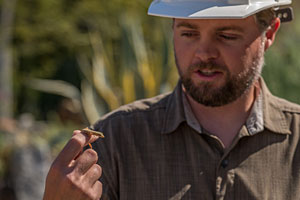
Greg Pauly’s Lost Lizards of Los Angeles project worked so well that it’s expanding. Photo/SoCal Wild
“Maybe you see a turtle at the park, or an alligator lizard in your yard, or maybe a salamander in the Santa Monica Mountains,” says Pauly. “You submit a photograph of it to our project, and that data will be available to scientists for generations to come.”
Coming up will be the citizen science component of Bioscan, a 3-year look at, among other things, the diversity of Los Angeles insects. Project Coordinator Dean Pentcheff is looking for a homeowners willing to host bug traps in their backyards and volunteers willing to sift through the take, sorting beetles from butterflies. A special side project in August will count bugs drawn to porchlights.
“We’re about three months in,” says Pentcheff, “and already we’ve found new species unknown to science.”
Pauly, the herpetologist, says such projects are especially important in places like Los Angeles County because the interface between the wilderness and the expanding urban landscape is on the cutting-edge of science these days.
“When you ask people here where they go to see nature, they say things like, ‘Sequoia’ or ‘Anza Borrego.’ But we’re surrounded by incredible diversity, and you don’t even have to leave L.A.”
Posted 6/13/13
End of the road for Metro freeloaders
June 13, 2013
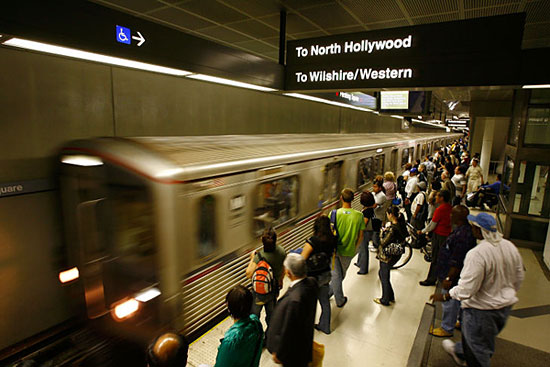
Starting next week, gates on L.A.'s subway system will be locking for good after years of debate and tests.
If you lock it, they will pay.
After extensive testing of latched turnstile gates and rollout of a new TAP card fare payment system, Los Angeles’ long, free trip on a subway without barriers is finally reaching the end of the line.
Next Wednesday, the subway gates at Union Station will be locked as a new era of public transportation rolls out in L.A., following more than two decades on an honor system that critics say unfairly penalizes paying passengers while leaving millions of dollars in revenue on the table.
David Sutton, Metro’s deputy executive officer in charge of the gate-latching project, said the lengthy testing period has been “a real eye-opener,” with consistent results in every test location: fewer boardings but a lot more paying customers using TAP cards.
“The data doesn’t lie,” Sutton said. “When we latch gates, we see less riders, more TAPs, more [vending machine] activity and more revenue.”
In 30 tests at Metro stations conducted earlier this year, sales at ticket vending machines spiked by nearly 30%, with 6,919 additional passengers paying to board trains, compared to the normal volume of paying passengers at each location.
Trains were less crowded because 14% fewer riders got onboard.
And as gate-latching tests intensified and enforcement was heightened, it seemed to create a lingering deterrent to would-be fare beaters. From October through December of 2012, fare evaders made up an estimated 18% of subway riders; from January through April of this year, with testing underway, that number dropped to 13%. So-called “fare checks” by sheriff’s deputies or security officers more than doubled—from 36,588 in October to 74,482 in April. And citations went through the roof, from 881 issued in October to 2,451 in April.
Overall, the testing results suggest that the agency could be able to recover between $6 million and $9 million annually in lost revenue once the subway and existing light rail gates are latched system-wide.
Supervisor and Metro Director Zev Yaroslavsky, a leader in efforts to get the gates latched, has made the case that it’s more than just a matter of money.
“It’s not fair to those people who pay to have a significant percentage of people who don’t pay,” he told the media last month. “The credibility of the enforcement system is undermined. It’s human nature to say, ‘If he’s getting away with it, why should I pay?’ ”
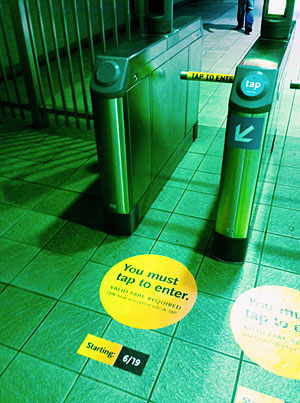
No tap-dancing around it: It will be mandatory to TAP to enter subway gates at Union Station starting Wednesday. Photo/Metro's The Source
It’s been more than 20 years since L.A.’s first subway—the Red Line—opened on an initial stretch of 4.4 miles. And it was five years ago that Metro’s Board of Directors voted to install gates in the subway and some light rail stations, citing security concerns and revenue losses of an estimated $5.5 million a year due to fare evasion.
“Metro remains the only subway operator in the country to operate a barrier-free system,” Yvonne B. Burke, then a Los Angeles County supervisor and Metro board member, said at the time. “That freedom has come at a significant cost to the agency’s bottom line as a result of fare scofflaws.”
Next week’s latching of the first subway gates can be seen as a coming of age moment in the progression of L.A.’s public transit system, which has grown exponentially in recent years and moved from comedian’s punch line to nationally-recognized point of pride.
But getting from there to here has been anything but an express trip when it came to getting the turnstiles locked.
One big stumbling block was the move from paper tickets to the TAP cards needed for passengers to be able to open locked gates. The transition initially prompted widespread confusion and complaints among would-be users, particularly seniors unable to find a way to buy their reduced-priced tickets in the new TAP system. New signs were installed and instructions on vending machine screens were retooled to simplify the process.
Regional transit agencies also needed to be recruited to join the TAP system; by the end of next year, 24 providers will be onboard. Integrating Metrolink passengers’ paper tickets with the TAP system proved to be a special challenge. Eventually, a special chip embedded in Metrolink tickets was developed so that passengers on the commuter rail system can get through locked gates when transferring to a Metro subway or light rail line.
A final test will be run Friday at Union Station, before the Red and Purple lines there are permanently latched on Wednesday, June 19. After that, work will begin on individual subway stations, with locked gates expected to be in place at all Red and Purple line stations by the end of August.
From there, the process moves to the transit system’s light rail stations, which cannot be completely locked because not all of those stations are equipped with gates. Light rail stations with gates on the Gold Line will be latched in October, on the Green Line in December and on the Blue Line in January, 2014.
Metro’s Sutton said the agency has heard some complaints during the lengthy gate-latching testing process but has received far more positive comments, chiefly along the lines of:
“Thank God. Why did you wait so long?”
Posted 6/13/13
Finding foot room at CicLAvia
June 6, 2013
Deborah Murphy’s first experience with CicLAvia was no smooth ride. She was walking her Jack Russell terrier down the sidewalk in East Hollywood when she decided to make a move to the car-free streets.
“Get out of the road with your dog, lady—this is for cyclists, stay off the street,” she remembers someone yelling.
When the next CicLAvia brought more shout-downs, the long-time pedestrian advocate and founder of Los Angeles Walks decided to form WalkLAvia, a group aimed at staking pedestrians’ claim to a share of the roads during the events.
“This is an open streets event and people should be out there walking or on bikes or doing cartwheels or whatever they want to do,” Murphy said.
No one would love to see that more than CicLAvia’s organizers, who’ve been pushing for that kind of inclusivity from the beginning. To make that point abundantly clear, they’re billing the upcoming
June 23 event along Wilshire Boulevard’s “Miracle Mile” as “the most walkable CicLAvia ever!”
“This all feeds into the ultimate purpose of CicLAvia—to connect people with their community in a way that is not possible in a car,” said CicLAvia spokesman Robert Gard. “On bike and, more specifically, on foot, you are really able to interact with your fellow Angelenos.”
But turning that long-held aspiration into a reality has proven increasingly elusive as the event’s popularity has grown. The last event, which opened a 15-mile stretch of streets from downtown to Venice Beach, drew a crowd of about 180,000 people, according to Gard. The overwhelming majority of them were on bikes. “There are so many bicyclists now, walking appears to not be part of it,” Gard said.
Unlike the last route, however, the new one along Wilshire Boulevard will be just 6 miles, with pedestrian-only zones at each end. Although architecture tours and other walker-friendly activities are planned, organizers think the location itself may lure more walkers. The Wilshire route will offer more street life and more sights—from MacArthur Park to Koreatown to “Miracle Mile,” with its museums and vibrant arts scene.
Of course, any event with “cycle” in its name is bound to attract a bike-heavy crowd. But part of the challenge is simple growing pains, Gard said. CicLAvia was inspired by ciclovías in Bogotá, Colombia, which began in the mid-1970s. L.A.’s first event was held just three years ago, and local cyclists jumped at the chance to freely ride streets, where automobile traffic normally makes biking nerve-wracking, even perilous.
Once people realize CicLAvia events are here to stay, bike riders won’t jump at the chance to ride every one of them for fear they’re missing a once-in-a-lifetime opportunity. “In talking with our peers in Central and South America, once they were more established, people understood it better,” Gard said. In time, serious bicyclists came to accept that ciclovías were for riders of all ability levels—and for pedestrians, too.
Alissa Walker, a member of Los Angeles Walks’ steering committee, said attitudes have already started to change.
“It has gotten a lot better,” Walker said. “At first, people didn’t understand that it wasn’t a race or something. It was possibly dangerous.”
CicLAvia organizers, in hoping to encourage that evolution, highlighted the problem using a video of a disabled man describing how he was verbally abused and directed off the streets because he was on a special, motorized device to accommodate his disability.
The City of Los Angeles’ first-ever pedestrian coordinator, Margot Ocañas, has participated in all six CicLAvias—sometimes on foot, sometimes on bike. She believes that continued, heavy interest from cyclists will mean that the roads “below the curb” will probably remain dominated by bikes, while pedestrians will take the sidewalks. For safety’s sake, she said, that’s not necessarily a bad thing.
Creating more pedestrian-only areas could help bring out more walkers, Ocañas said. She also envisions using the main route as a “launch pad for walking activities that tentacle off into other areas.”
No matter how CicLAvia evolves, everyone agrees that it should keep on rolling, stepping and hula-hooping.
“The fact that the bikes and pedestrians are having that conversation,” Ocañas said, “I’ll take it any day over bikers or pedestrians having that conversation with a car.”
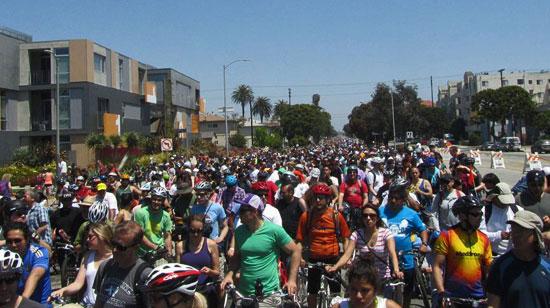
There were so many cyclists at April's event that they became walkers, like on this stretch of Venice Boulevard.
Posted 6/6/13
Group swim meetup? Better get an OK
June 6, 2013
For the L.A. Tri Club, a Santa Monica-based triathletes organization, there are few better places to train for their running, swimming and bicycling contests than Malibu’s Zuma Beach.
But last summer, they hit choppy waters.
“A member was posting on our website, saying ‘I’m going to swim on Saturday at 8 a.m., come along,” club president Paul Hekimian remembers. “But when we got out there, the lifeguards were saying we needed to pull a permit.”
The problem? Thanks to the power of social networking, there was a crowd in the ocean—a phenomenon that has been happening with ever greater frequency.
“It’s something we’ve seen for a while on the land, with people who train for marathons and so forth,” says Kerry Silverstrom, chief deputy director of the Los Angeles County Department of Beaches and Harbors. “But now we’re seeing it more and more with organized water activity.
“We want to make sure that we know when these groups are coming, so they don’t interfere with ordinary beach access or something we’ve scheduled, and so we can make sure that they’re safe.”
That’s why the Board of Supervisors this week made some adjustments to the county’s policy on beach permits for organized summer activities at county owned or operated beaches, stretching from Nicholas Canyon above Malibu to White Point/Royal Palms beach along the Palos Verde penninsula. The only exemptions are for city-managed beaches in Santa Monica and Hermosa.
In years past, the only organized, regularly occurring activities allowed during the busy summer beach season were those conducted during business hours on weekdays by groups such as surf or day camps that bid on specific locations as part of a competitive process. Others—such as, say, big groups of swimmers who wanted to work out together—typically were denied summer permits by Beaches and Harbors or turned away if authorities caught them, even when the beach was less busy.
But in the last couple of years, Silverstrom says, demand from water sports enthusiasts and fitness groups have intensified to the point that the department decided to expand its policy. Permits will now be available for regular gatherings of groups such as swim clubs, triathlete teams and paddleboard meetups, as well as for organized summer recreation in the early mornings and evenings.
But the new rules come with a cost that’s unlikely to put some applicants in a sunny mood.
Like other groups now using the beach, they’ll have to pay a $200 administrative fee (click here for an online application), produce proof of liability insurance and reimburse the county for the cost—about $50 an hour, on average—of any extra lifeguards.
There is no size threshold for water activity groups, partly, officials say, because most of the water-based crowds have sprung from social networks, which tend to produce a variable turnout.
“Someone on Facebook will want to meet up for yoga on paddleboards, and one week 12 people will show up, and the next week there’ll be two,” says Beaches and Harbors spokeswoman Carol Baker. “But whatever the size, if something happens, the lifeguards are the first responders and have to know who’s out there.”
The fine-tuning comes two years after an overhaul of Beaches and Harbor’s permitting system, which is only now being rigorously enforced as grace periods have ended and a team of code enforcement officers has come online.
Beach users have mixed reactions. The off-peak permit decision delighted Sarah Tiefenthaler, whose standup paddleboard yoga class, YOGAqua, had to move this summer because she lacked a permit to continue operating in Marina Del Rey on weekends.
“It’s wonderful to hear that there’s even a glimmer of hope,” Tiefenthaler says, adding that if she can get back into her old Mothers Beach location, she won’t mind the permit fees.
Meetup groups are less sanguine, however.
“I think this is murky,” says Hekimian of L.A. Tri Club. Though scofflaws can be fined from $100 to $500 for gathering without a permit, he notes, social networks like his have no clear lines of responsibility.
“It’s like a member of Facebook saying, ‘I’m going for a workout, who wants to join me?’” he says. “If that member doesn’t get a permit, who gets the bill? Facebook?”
Beaches and Harbors officials say that no group gathers en masse unless someone’s organized it, and that they don’t care who pays as long as someone gets a permit.
“When 30 people jump in the water for a swim at seven in the morning, it’s really important that lifeguards be there,” says Baker, who adds that “some of these meetup groups say they’re not organized and then you go online and see that they are.”
As the new rules settle in, eight code enforcement officers will be patrolling the beach this summer with an eye out for groups that appear to be organized.
“We’ll issue them a flyer the first time we meet them, and tell them that if they’re conducting a business or an organized activity, they need a permit,” says Vivian Sanner, who is handling beach code enforcement at the department.
“If they say, ‘No, we’re just a bunch of friends,’ we’ll let it go the first time. But if we see them again, same time, same place, we won’t be as nice.”
Posted 6/6/13
Lowering the heat on bonfire dispute
June 5, 2013
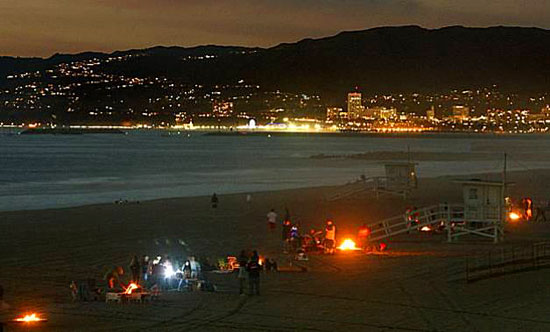
A shift in direction by air quality officials could keep fires burning on Dockweiler State Beach. Photo/L.A. Times
A hotly contested proposal to ban wood burning in Southern California’s iconic beach fire rings appears to be going up in smoke.
An official with the South Coast Air Quality Management District said in an interview on Wednesday that “an alternative proposal” had been developed that would continue to allow bonfires on the region’s beaches so long as certain measures were undertaken by June, 2014, to minimize the known harmful effects of burning wood.
“From our standpoint, we have better and more information than we had two months ago,” said AQMD project manager Tracy Goss. “A one-size-fits-all doesn’t necessarily apply in this case.”
And that’s good news for the popular pits at Dockweiler State Beach, which, under the earlier proposal, would have fallen victim to a dispute flaring 50 miles south, where Newport Beach officials are determined to remove 60 fire rings. Some residents there have complained of respiratory problems and smoke-drenched homes. At Dockweiler, the neighbors include LAX, a sewage treatment plant and an oil refinery, and they’re not complaining.
Restricting fires at Dockweiler for health reasons “doesn’t make a whole lot of sense,” Goss acknowledged, noting that the latest proposal would take a more nuanced beach-by-beach approach based on such things as topography, wind and proximity to homes. Goss declined to provide specifics until the plan’s public release, scheduled for Thursday. Already, the agency has two “public consultation meetings” set for next week on the new proposed amendments to Rule 444, which regulates “open burning.”
Of the national attention the AQMD’s earlier proposal attracted, Goss, a 25-year veteran of the agency, said: “When they make a political cartoon of your issue, that doesn’t happen very often.”
Kerry Silverstrom, chief deputy director of L.A. County’s Department of Beaches and Harbors, welcomed the news that Dockweiler’s fire pits will likely be spared. “We’re delighted,” she said. But she questioned why they were ever at risk. “On the scale of what’s bad for us,” she said, “fire rings at Dockweiler wouldn’t be the first thing I’d be talking about.”
She said the concrete rings have been there since at least the mid-1970s, when the county began running the beach at the foot of Imperial Highway. As much as 43 percent of Dockweiler’s annual parking revenues, or $570,000, comes from fees after 4 p.m., Silverstrom said—clear evidence of the popularity of the rings. “They provide a low cost recreational opportunity for a diverse population,” she said. “We see it as an access issue.”
So did the staff of the California Coastal Commission when, in February, it recommended denying Newport Beach a permit to remove fire pits that the mayor and city council contended were jeopardizing residents’ health. (Critics accused homeowners of simply trying to discourage undesirable outsiders from flocking to their affluent neighborhood.)
The commission staff stated that the removal of the rings would “deny the public access to this popular form of lower cost public recreation.” It also said the city had failed to demonstrate that the rings were “directly responsible” for health problems.
It was around this time that the AQMD entered the fray at the urging of board chairman William Burke, who also sat on the Coastal Commission—a job from which he’d resign as questions arose in Sacramento over a potential conflict between his positions on two agencies at odds with each other.
More specifically, Burke’s departure came after he said during an AQMD meeting in February that a nighttime aerial picture of the Newport fire rings reminded him of “carpet bombing” in Viet Nam, where he’d served in the armed forces. “This is Viet Nam revisited,” Burke said, but then quickly added: “Now it’s not really that bad because Viet Nam was horrible.”
As the AQMD continued to push for a regional ban, other cities pushed back, most notably Huntington Beach, which said its fire rings were a source of pride and commerce; they help “surf city” reap $1 million annually in parking revenues.
On Tuesday, the city’s community relations officer, Laurie Frymire, appeared before members of the Los Angeles County Board of Supervisors. “Our fire rings have been enjoyed for more than 60 years by folks from all over,” Frymire said, as she thanked supervisors for passing a motion by Don Knabe, whose 4th District includes Dockweiler Beach. The motion called on the board to oppose any action by the AQMD to ban fire rings region-wide and to leave such decisions to local jurisdictions. The Orange County Board of Supervisors, among other local government bodies, had earlier passed similar measures.
Now, given the shift in position by the AQMD staff, it looks increasingly likely that, at least in L.A. County, fire pits will no longer be a burning issue.
Posted 6/5/13
Bus lanes a peak event on Wilshire
June 4, 2013
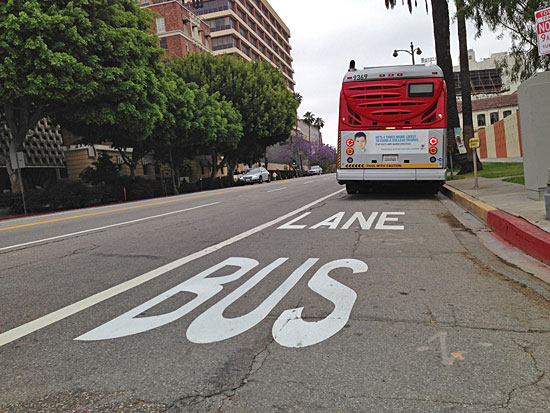
With the launch of a bus lane on Wilshire, a new chapter in the street's storied traffic history was opened.
Every two minutes during rush hours, Metro buses roll—or, rather, crawl—down Wilshire Boulevard, carrying tens of thousands of riders along one of Los Angeles County’s most clogged arteries.
But beginning Wednesday, those passengers may find a modest measure of relief from the blockage with a new 1.8 mile stretch of curbside bus lanes between MacArthur Park and Western Avenue. By late next year, according to Metro officials, the Wilshire Boulevard Bus Rapid Transit (BRT) lanes will span 7.7 miles—with a one-mile gap through Beverly Hills—ending at Centinela on the border of Santa Monica.
Metro predicts that the $31 million project could improve peak-hour travel times for riders by as much as 24 percent, or 15 minutes, between downtown and Santa Monica.
During a media briefing and ribbon-cutting on Tuesday, Metro board member and County Supervisor Zev Yaroslavsky, who’s long championed dedicated bus lanes, called the introduction of the Wilshire BRT’s first segment “a signal day for Los Angeles.”
With quicker, less stressful trips for bus riders, Yaroslavsky said, “there’s no question that their quality of life will be improved significantly.”
Yaroslavsky acknowledged that there’s been speculation and anxiety among some commuters over the potential traffic impact of eliminating a lane for cars in each direction during rush hours. “I hope people will give it a chance,” he said, then added: “I know they will.”
Dedicated bus lanes are seen as a crucial component in Los Angeles’ multi-faceted effort to reduce the region’s legendary traffic and encourage the use of mass transit—from subways to light rail to dedicated busways—all of which have increasingly been embraced by the public. Metro officials hope that the Wilshire Boulevard BRT will coax even more drivers out of their cars when they see a potentially faster alternative.
Metro’s project manager for the Wilshire BRT, Martha Butler, acknowledged that there could be some initial congestion in the “mixed use” lanes as drivers adjust to the famous boulevard’s new peak-hour realities. “But they’ll get more used to it,” she said, as the project progresses, one segment at a time.
Butler also said there’ll be “a grace period,” during which Los Angeles police officers will give warnings to drivers who improperly use the lanes on weekdays between 7- 9 a.m. and 4- 7 p.m. After that, they’ll get ticketed.
In all, the Wilshire BRT will encompass 12.5 miles, although only 7.7 miles will have designated bus lanes. The project, funded with a mix of federal and local monies, will also include street and signage improvements.
Before the Wilshire BRT project, the only other designated bus lanes in L.A. were along Figueroa Street from Adams Boulevard to 7th Street in the Downtown area. For more information, click here.
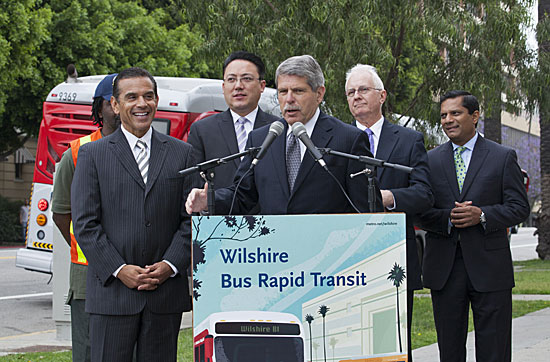
Supervisor Yaroslavsky said the first segment of the Wilshire bus lanes represented "a signal event in Los Angeles." Photo by Josh Southwick/Metro
Posted 6/4/13




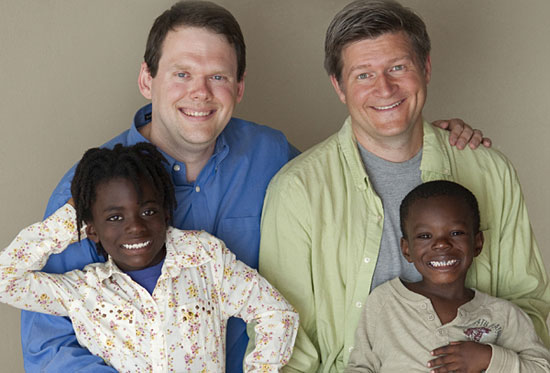
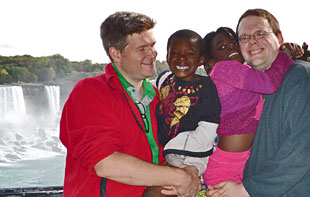
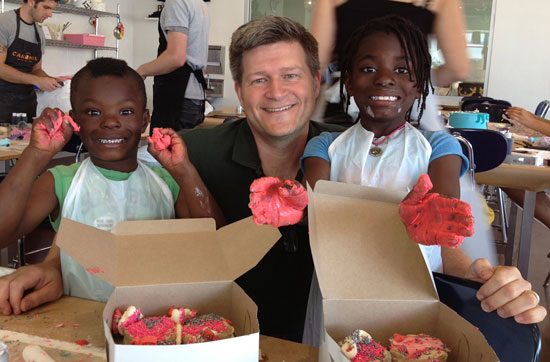
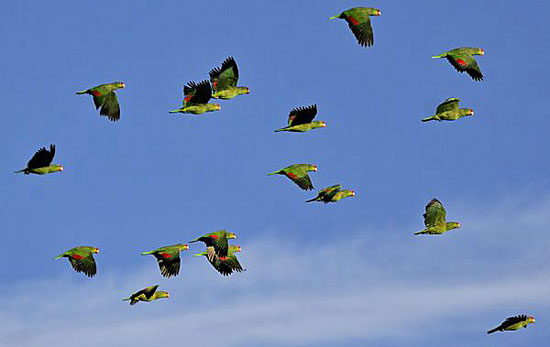
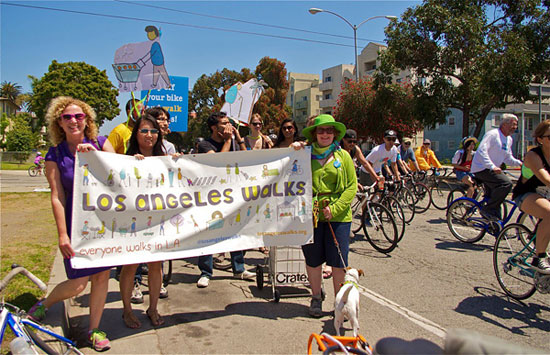
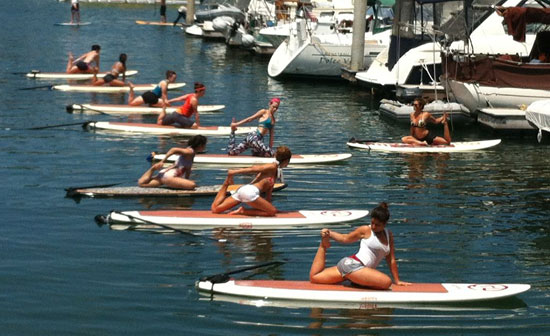






 Check for the latest closure information
Check for the latest closure information








